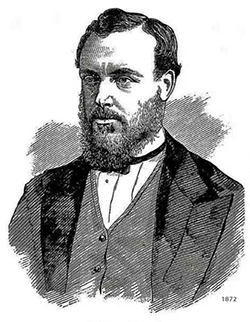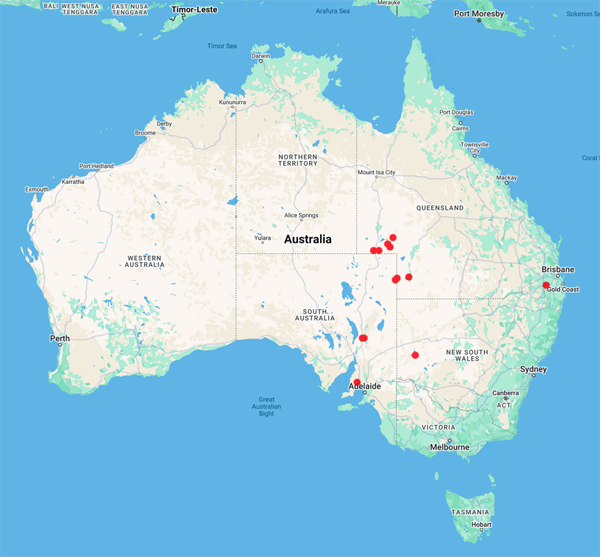
Council of Heads of Australasian Herbaria
Australian National Herbarium
Biographical Notes
 |
Council of Heads of Australasian Herbaria |
 Murray, James Patrick (1839 - c.1885)
Murray, James Patrick (1839 - c.1885)Born in Roscommon, Co. Connaught, Ireland, 1839; died in England?, c.1885.
After having been
admitted as a Licentiate of the Royal College of
Surgeons of Ireland, he emigrated to Melbourne in
1860.
For about a year, he worked as a surgeon
at the Melbourne Hospital.
He then joined the
expedition, headed by Alfred Howitt, to bring
back the remains of Burke and Wills from Cooper
Creek for burial in Melbourne.
On this expedition
Murray's duty were to act
in the dual capacity of surgeon and plant collector.
The party reached the Cooper Creek depot on
2nd March 1862, with
Murray placed in charge of the camp where, with
the exception of an excursion with Howitt to the
Diamantina River between 4th July and the 2nd
August, he remained until 10th October 1862 when
the party departed for Adelaide.
During his time at the Cooper's Creek depot (in
Qld) Murray made an extensive collection of
plants in that vicinity, (J.H. Willis recording
that 96 species were gathered).
On the Diamantina River trip, during which Howitt
and Murray journeyed through Sturt's "Stony
Desert", yielded additional species, with Willis
noting that, altogether, Murray's collection
during the expedition embraced about
130 species.
Willis also noted that
"a valuable collection" of wood specimens was
brought back to Melbourne by Murray.
In Melbourne, Ferdinand Mueller received
Murray's plant collection in late January 1863
and in his annual report of that year (dated April 1863) listed 114 species received
from him.
After the Howitt expedition, Murray spent
two years in New Zealand before returning to
Melbourne.
He then became involved in yet another
expedition organised by Ferdinand Mueller and
the Ladies' Leichhardt Search Committee (LLSC).
This expedition water under the
leadership of Duncan McIntyre, with Murray
joining the expedition as second-in-command and
"Surgeon and Assistant Astronomer".
When the
party reached Cooper's Creek on 26 November
1865, McIntyre and another member of the party
went ahead to search for water. Murray and others
remained at the Cooper. In McIntyre's absence,
Murray acted poorly, probably indulging in an
alcoholic binge, and lost horses and equipment.
For this behaviour, he was sent back to Melbourne
and was denounced for his "cowardly desertion"
of McIntyre.
He married in 1866 and
had three children.
Massacre
In early 1871
Murray decided to be involved in 'Blackbirding',
a potentially lucrative business involving kidnapping Pacific Island native people for labour in the Queensland sugarcane and cotton plantations (akin to slavery).
In April
1871 Murray purchased the brig Carl and sailed
off in pursuit of a fortune. However, in doing so,
he was to head "the greatest massacre of South
Sea Islanders in the annals of the South Sea slave
trade".
On the night of 14
September 1871, Murray led the crew in a bloody
massacre of 70 natives held below decks.
The
detailed accounts of his murderous actions from the trial records of the subsequent court cases in Sydney are
sickening.
Murray turned Queen's evidence
(i.e. he alerted authorities to the criminal activity and testified against others),
allowing him to remain a free man.
Murray was soon back practicing as as a surgeon in Melbourne, but was soon exposed and hounded by the Melbourne press as news from the Sydney court cases became known.
A few weeks later (in January 1873), Murray left for
England leaving his wife and children behind.
His name is unfortnately attached to at least two plant species:
- Acacia murrayana F.Muell. ex Benth.
- Ptilotus murrayi F.Muell.
Source: Extracted from:
Short, Philip, 'James Patrick Murray, from "a very superior practitioner" and plant collector to a "murdering mawworm", ASBS Newsletter, No.200 Sept 20024 p.26-29
Pearn, J. (2001). 'A Doctor in the Garden: nomen
medici in botanicis: Australian Flora and the World
of Medicine'. Amphion Press, Brisbane.
https://bellsinequality.wordpress.com/tag/kidnapping/
Portrait Photo: The Australian Town and Country Journal, 8 March 1873.
Data from 127 specimens
